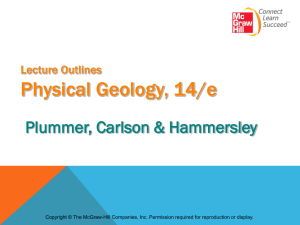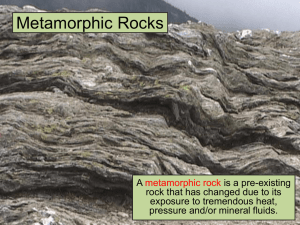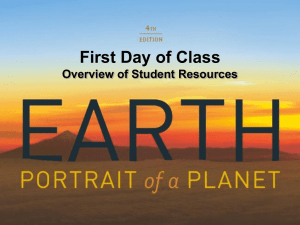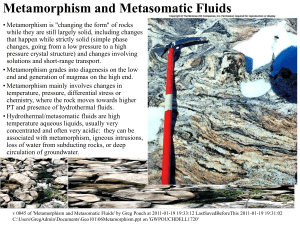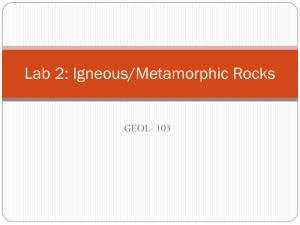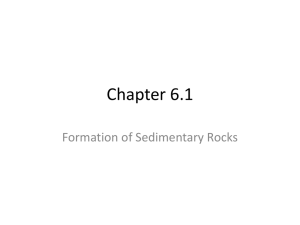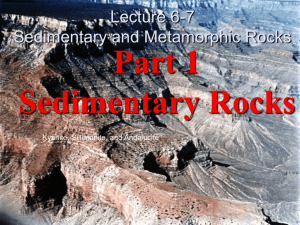Metamorphism
advertisement
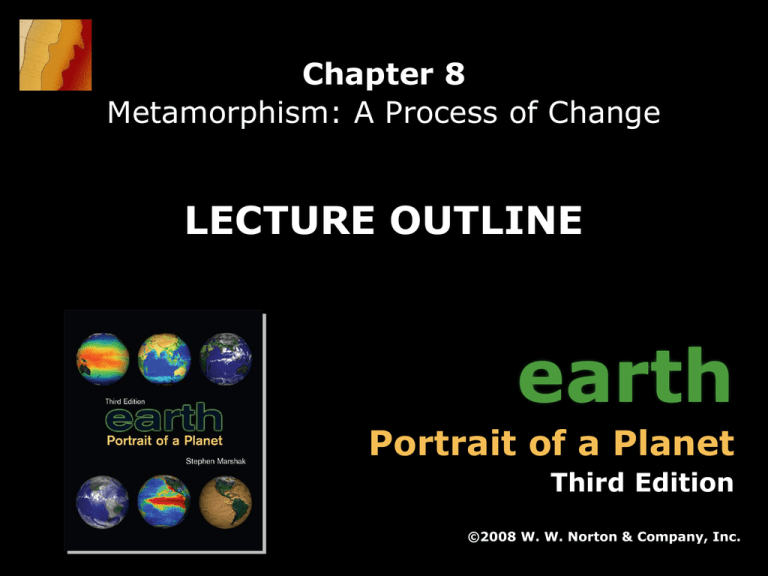
Chapter 8 Metamorphism: A Process of Change LECTURE OUTLINE earth Portrait of a Planet Third Edition ©2008 W. W. Norton & Company, Inc. Earth: Portrait of a Planet, 3rd edition, by Stephen Marshak Chapter 8: Metamorphism: A Process of Change Metamorphism: A Process of Change Prepared by Ron Parker Earlham College Department of Geosciences Richmond, Indiana Introduction Metamorphic – Changed from an original “parent.” Meta = Change. Morph = Form or shape. Parent rocks are called “protoliths.” Metamorphism can occur to any protolith. Earth: Portrait of a Planet, 3rd edition, by Stephen Marshak Chapter 8: Metamorphism: A Process of Change Introduction Protoliths undergo pronounced changes in… Texture. Mineralogy. Due to change in physical or chemical conditions. Burial. Tectonic stresses. Heating by magma. Fluid alteration. Earth: Portrait of a Planet, 3rd edition, by Stephen Marshak Chapter 8: Metamorphism: A Process of Change Metamorphism Metamorphism occurs in the solid state. It doesn’t include weathering, diagenesis, melting. Metamorphics often look totally unlike protoliths. Earth: Portrait of a Planet, 3rd edition, by Stephen Marshak Chapter 8: Metamorphism: A Process of Change Metamorphic Character Metamorphic rocks have distinctive properties. Unique texture – Intergrown and interlocking grains. Unique minerals – Some that are only metamorphic. Staurolite, Kyanite, Sillimanite, etc. Unique foliation – A planar fabric from aligned minerals. These transformations can change the rock utterly. Fossiliferous limestone Red mudstone Garnet gneiss Earth: Portrait of a Planet, 3rd edition, by Stephen Marshak Marble Chapter 8: Metamorphism: A Process of Change Metamorphic Processes Metamorphic change is slow and in the solid state. Several processes are at work. Recrystallization – Minerals change size and shape. Phase change – New minerals form with… Same chemical formula. Different crystal structure. Earth: Portrait of a Planet, 3rd edition, by Stephen Marshak Kyanite Chapter 8: Metamorphism: A Process of Change Metamorphic Processes Several processes may operate at the same time. Neocrystallization – New minerals with P-T changes. Initial minerals become unstable; change to new minerals. Decomposition of the original minerals in the protolith. Chemical reaction of the elements to form new minerals. In this way, a shale can transform into a garnet mica schist. Earth: Portrait of a Planet, 3rd edition, by Stephen Marshak Chapter 8: Metamorphism: A Process of Change Metamorphic Processes Several processes may operate at the same time. Pressure solution – Mineral grains partially dissolve. Plastic deformation – Mineral grains soften and deform. Earth: Portrait of a Planet, 3rd edition, by Stephen Marshak Chapter 8: Metamorphism: A Process of Change Causes of Metamorphism The agents of metamorphism are… Heat (Temperature – T). Pressure (P). Differential stress. Hydrothermal fluids. Not all agents are required; they often do co-occur. Rocks may be overprinted by multiple events. Earth: Portrait of a Planet, 3rd edition, by Stephen Marshak Chapter 8: Metamorphism: A Process of Change Heat (Temperature) Metamorphism occurs as the result of heat. Temperature (T) ranges between 200oC and 850oC. The upper T limit is…melting. It varies based upon rock mineral composition and water content. Heat energy breaks and reforms atomic bonds. Sources of heat. The geothermal gradient. Magmatic intrusions. Compression. Earth: Portrait of a Planet, 3rd edition, by Stephen Marshak Chapter 8: Metamorphism: A Process of Change Pressure (P) P increases with depth in the crust. 270 to 300 bars per km (1 bar is almost 1 atm = 14.7 psi). Metamorphism occurs mostly in 2 to 12 kbar range. T and P both change with depth. Mineral stability is highly dependent upon T and P. This stability can be graphed on a “phase diagram.” Changes in T and P lead to changes in minerals. Earth: Portrait of a Planet, 3rd edition, by Stephen Marshak Chapter 8: Metamorphism: A Process of Change Differential Stress Pressure that is greater in one orientation. A commonplace result of tectonic forces. Two kinds of differential stress: Normal and shear. Normal stress – Operates perpendicular to a surface. Tension – Pull-apart normal stress. Compression – Push-together normal stress. Earth: Portrait of a Planet, 3rd edition, by Stephen Marshak Chapter 8: Metamorphism: A Process of Change Differential Stress Two kinds of differential stress: Normal and shear. Shear stress – Operates sideways across a surface. Causes material to be “smeared out.” Earth: Portrait of a Planet, 3rd edition, by Stephen Marshak Chapter 8: Metamorphism: A Process of Change Differential Stress At higher T and P, differential stress deforms rock. Rocks change shape slowly without breaking. Earth: Portrait of a Planet, 3rd edition, by Stephen Marshak Chapter 8: Metamorphism: A Process of Change Differential Stress Deformation acts on minerals with specific shapes. Equant – Roughly equal in all dimensions. Inequant – Dimensions not the same. Platy (pancake-like) – 1 dimension shorter. Elongate (cigar-shaped) – 1 dimension longer. Differential stress causes these minerals to align. Alignment fabric records stress trajectory. Earth: Portrait of a Planet, 3rd edition, by Stephen Marshak Chapter 8: Metamorphism: A Process of Change Differential Stress Preferred platy mineral alignment is called foliation. Foliation imparts a layered or banded appearance. Rocks commonly break parallel to foliation planes. Foliation develops perpendicular to compression. Minerals flatten, recrystallize, and rotate. Inequant grains align by rotation and new growth. Earth: Portrait of a Planet, 3rd edition, by Stephen Marshak Chapter 8: Metamorphism: A Process of Change Hydrothermal Fluids Hot water with dissolved ions and volatiles. Hydrothermal fluids facilitate metamorphism. Accelerate chemical reactions. Alter rocks by adding or subtracting elements. Hydrothermal alteration is called metasomatism. Earth: Portrait of a Planet, 3rd edition, by Stephen Marshak Chapter 8: Metamorphism: A Process of Change Metamorphic Rock Types Two major subdivisions of metamorphic rocks. Foliated – Has a through-going planar fabric. Subjected to differential stress. Has a significant component of platy minerals. Classified by composition, grain size, and foliation type. Earth: Portrait of a Planet, 3rd edition, by Stephen Marshak Chapter 8: Metamorphism: A Process of Change Metamorphic Rock Types Two major subdivisions of metamorphic rocks. Non-foliated – No planar fabric evident. Crystallized without differential stress. Comprised of equant minerals only. Classified by mineral composition. Earth: Portrait of a Planet, 3rd edition, by Stephen Marshak Chapter 8: Metamorphism: A Process of Change Metamorphic Rocks Slate – Fine clay, low-grade metamorphic shale. Has a distinct foliation called slaty cleavage. Develops by parallel alignment of platy clay minerals. Slaty cleavage oriented perpendicular to compression. Slate breaks along this foliation creating flat sheets. Earth: Portrait of a Planet, 3rd edition, by Stephen Marshak Chapter 8: Metamorphism: A Process of Change Metamorphic Rocks Phyllite - Fine mica-rich rock. Formed by low – medium grade alteration of slate. Clay minerals neocrystallize into tiny micas. Micas reflect a satiny luster. Phyllite is between slate and schist. Earth: Portrait of a Planet, 3rd edition, by Stephen Marshak Chapter 8: Metamorphism: A Process of Change Metamorphic Rocks Schist – Fine - coarse rock with larger micas. Medium-to-high-grade metamorphism. Has a distinct foliation called schistosity. Parallel alignment of large mica crystals. Micas are visible because they have grown at higher T. Schist often has other minerals due to neocrystallization. Quartz. Feldspars. Kyanite. Garnet. Staurolite. Sillimanite. Large non-mica minerals are called porphyroblasts. Earth: Portrait of a Planet, 3rd edition, by Stephen Marshak Chapter 8: Metamorphism: A Process of Change Metamorphic Rocks Gneiss – Has a distinct banded foliation. Light bands of felsic minerals (quartz and feldspars). Dark bands of mafic minerals (biotite or amphibole). Earth: Portrait of a Planet, 3rd edition, by Stephen Marshak Chapter 8: Metamorphism: A Process of Change Metamorphic Rocks Compositional banding develops in several ways. Original layering in the protolith. Extensive high T shearing. Earth: Portrait of a Planet, 3rd edition, by Stephen Marshak Chapter 8: Metamorphism: A Process of Change Metamorphic Rocks Compositional banding Solid-state chemical differentiation. Earth: Portrait of a Planet, 3rd edition, by Stephen Marshak Chapter 8: Metamorphism: A Process of Change Migmatite Migmatite is a partially melted gneiss. It has features of igneous and metamorphic rocks. Mineralogy controls behavior. Light-colored (felsic) minerals melt at lower T. Dark-colored (mafic) minerals melt a higher T. Felsics melt first; mafics remain metamorphic. Earth: Portrait of a Planet, 3rd edition, by Stephen Marshak Chapter 8: Metamorphism: A Process of Change Metamorphic Rocks Non-foliated rocks lack a planar fabric. Absence of foliation possible for several reasons. Rock not subjected to differential stress. Dominance of equant minerals. Absence of platy minerals. Earth: Portrait of a Planet, 3rd edition, by Stephen Marshak Chapter 8: Metamorphism: A Process of Change Metamorphic Rocks Amphibolite – Dominated by amphibole minerals. Basalt or gabbro protolith. Usually not well foliated. Hornfels – Alteration by heating. Associated with plutonic intrusions. Finely crystalline. Earth: Portrait of a Planet, 3rd edition, by Stephen Marshak Chapter 8: Metamorphism: A Process of Change Metamorphic Rocks Quartzite – Almost pure quartz in composition. Forms by alteration of quartz sandstone. Sand grains in the protolith recrystallize and fuse. Like quartz, it is hard, glassy, and resistant. Metamorphic Alteration Earth: Portrait of a Planet, 3rd edition, by Stephen Marshak Chapter 8: Metamorphism: A Process of Change Metamorphic Rocks Marble - Coarsely crystalline calcite or dolomite. Forms from a limestone or dolostone protolith. Extensive recrystallization completely changes the rock. Original textures and fossils in the parent are obliterated. Used as a decorative and monument stone. Exhibits a variety of colors. Metamorphic Alteration Earth: Portrait of a Planet, 3rd edition, by Stephen Marshak Chapter 8: Metamorphism: A Process of Change Metamorphic Rocks Type depends on protolith. Minerals contribute elements. Some protoliths yield specific rocks. Broad compositional classes. Pelitic. Basic (or Mafic). Calcareous. Quartzo-feldspathic. Earth: Portrait of a Planet, 3rd edition, by Stephen Marshak Chapter 8: Metamorphism: A Process of Change Metamorphic Classes Pelitic – Shale protoliths. Al-rich clay minerals yield micas. Rock type depends on grade. Slate. Phyllite. Schist. Gneiss. Earth: Portrait of a Planet, 3rd edition, by Stephen Marshak Chapter 8: Metamorphism: A Process of Change Metamorphic Classes Mafic – Basalt or gabbro protolith. Rich in Fe and Mg and poor in Si, Al, Na, and K. Turn into biotite- and amphibole-dominated rocks. Earth: Portrait of a Planet, 3rd edition, by Stephen Marshak Chapter 8: Metamorphism: A Process of Change Metamorphic Classes Calcareous – Carbonate protolith. Rich in Ca (limestones) and Ca and Mg (dolostones). Recrystallize into calcite and dolomite marbles. Earth: Portrait of a Planet, 3rd edition, by Stephen Marshak Chapter 8: Metamorphism: A Process of Change Metamorphic Classes Quartzo-feldspathic – Granitic protolith. Quartz + feldspar in granites stable under metamorphism. Recrystallize and become foliated into granitic gneisses. Earth: Portrait of a Planet, 3rd edition, by Stephen Marshak Chapter 8: Metamorphism: A Process of Change Metamorphic Intensity Different minerals are stable as T and P changes. Grade is a measure of metamorphic intensity. Low grade – Slight. High grade – Intense. Earth: Portrait of a Planet, 3rd edition, by Stephen Marshak Chapter 8: Metamorphism: A Process of Change Metamorphic Intensity Specific minerals typify particular grades. Earth: Portrait of a Planet, 3rd edition, by Stephen Marshak Chapter 8: Metamorphism: A Process of Change Metamorphic Grade Prograde – Metamorphism via increasing T and P. Common in rocks that are buried in orogenic belts. Progressive changes. Recrystallization causes mineral growth. Neocrystallization results in new mineral assemblages. Mineral changes release water. Earth: Portrait of a Planet, 3rd edition, by Stephen Marshak Chapter 8: Metamorphism: A Process of Change Metamorphic Grade Example: Prograde metamorphism of a pelitic rock. Low grade – Shale protolith. Clays recrystallize into larger, aligned clays to yield a slate. Clays neocrystallize into tiny, aligned micas in a phyllite. Intermediate grade – Micas recrystallize and grow large to form a schist. New minerals grow in the schist. High grade – Micas decompose; elements recombine into new minerals. Neocrystallization yields quartz and feldspars in a gneiss. Earth: Portrait of a Planet, 3rd edition, by Stephen Marshak Chapter 8: Metamorphism: A Process of Change Metamorphic Grade Retrograde – Metamorphism via decreasing T and P Common in rocks that are brought from depth by erosion. Accompanied by addition of H2O by hydrothermal fluids. Many prograde rocks aren’t “retrograded.” Rocks at the surface can preserve prograde conditions. Earth: Portrait of a Planet, 3rd edition, by Stephen Marshak Chapter 8: Metamorphism: A Process of Change Contact Metamorphism Certain minerals have a limited P-T range. These “index minerals” record metamorphic grade. Index mineral maps. Define metamorphic zones. Grade boundaries called isograds. Earth: Portrait of a Planet, 3rd edition, by Stephen Marshak Chapter 8: Metamorphism: A Process of Change Metamorphic Facies Metamorphic facies – Mineral assemblage from a specific protolith at specific P-T conditions. The same minerals result from the same… Protoliths. T and P conditions. Named for dominant mineral. Earth: Portrait of a Planet, 3rd edition, by Stephen Marshak Chapter 8: Metamorphism: A Process of Change Metamorphic Environments Metamorphism occurs in different settings. Different settings yield different effects via… Geothermal gradient. Differential stresses. Hydrothermal fluids. These characteristics are governed by tectonics. Earth: Portrait of a Planet, 3rd edition, by Stephen Marshak Chapter 8: Metamorphism: A Process of Change Metamorphic Environments The types (and settings) of metamorphism are... Thermal – Heating by a plutonic intrusion. Burial – Increases in P and T by deep burial in a basin. Dynamic – Shearing in a fault zone. Regional – P and T alteration due to orogenesis. Hydrothermal – Alteration by hot water leaching. Subduction – High P–Low T alteration. Shock – Extreme high P attending a bolide impact. Mantle – Extreme high mantle P causes phase changes. Earth: Portrait of a Planet, 3rd edition, by Stephen Marshak Chapter 8: Metamorphism: A Process of Change Contact Metamorphism Due to heat from magma invading host rock. Creates zoned bands of alteration in host rock. Called a contact (or metamorphic) aureole. The aureole surrounds the plutonic intrusion. Zoned from high (near pluton) to low grade (far from pluton). Earth: Portrait of a Planet, 3rd edition, by Stephen Marshak Chapter 8: Metamorphism: A Process of Change Contact Metamorphism Grades of alteration form bands around the pluton. Bands range from highly altered to slightly altered. Analogous to changes in pottery with increased heating. The width of each aureole zone is due to… The size of the plutonic intrusion. The degree of metasomatism. The dominant rock is hornfels. Earth: Portrait of a Planet, 3rd edition, by Stephen Marshak Chapter 8: Metamorphism: A Process of Change Burial Metamorphism As sediments are buried in a sedimentary basin… P increases because of the weight of the overburden. T increases because of the geothermal gradient. Requires burial below diagenetic effects. This is ~ 8–15 km depending on the geothermal gradient. Earth: Portrait of a Planet, 3rd edition, by Stephen Marshak Chapter 8: Metamorphism: A Process of Change Dynamic Metamorphism Breakage of rock by shearing at a fault zone. Fault location determines type of alteration. Shallow crust – Upper 10-15 km. Rocks behave in a brittle fashion. Mineral grains crush and pulverize forming fault breccia. Deeper crust – Below 10-15 km. Rocks behave in a ductile manner. Minerals smear like taffy to form mylonite. Earth: Portrait of a Planet, 3rd edition, by Stephen Marshak Chapter 8: Metamorphism: A Process of Change Regional Metamorphism Tectonic collisions deform huge “mobile belts.” Directed compression thickens mountains. Rocks caught up in mountain building are… Heated via the geothermal gradient and plutonic intrusions. Squeezed and heated by deep burial. Smashed and sheared by differential stresses. Earth: Portrait of a Planet, 3rd edition, by Stephen Marshak Chapter 8: Metamorphism: A Process of Change Regional Metamorphism Regional metamorphism creates foliated rocks. This type of metamorphism is, by far, the most important in terms of the amount of rock altered. Collisional belts are often… 1000s of km long. 100s of km wide. Earth: Portrait of a Planet, 3rd edition, by Stephen Marshak Chapter 8: Metamorphism: A Process of Change Hydrothermal Metamorphism Alteration by hot, chemically aggressive water. A dominant process near mid-ocean ridge magma. Cold ocean water seeps into fractured crust. Heated by magma, this water then reacts with mafic rock. The hot water rises and is ejected via black smokers. Earth: Portrait of a Planet, 3rd edition, by Stephen Marshak Chapter 8: Metamorphism: A Process of Change Subduction Metamorphism Subduction creates the unique blueschist facies. Trenches and accretionary prisms have… A low geothermal gradient – low temperature. High pressures. High P – Low T favor glaucophane, a blue amphibole mineral. Earth: Portrait of a Planet, 3rd edition, by Stephen Marshak Chapter 8: Metamorphism: A Process of Change Shock Metamorphism Rarely, Earth is struck by a comet or asteroid. Impacts generate a compressional shock wave. Extremely high pressure. Heat that vaporizes or melts large masses of rock. These conditions generate high-pressure minerals. Coesite. Stishovite. Earth: Portrait of a Planet, 3rd edition, by Stephen Marshak Chapter 8: Metamorphism: A Process of Change Exhumation How do metamorphic rocks return to the surface? Exhumation is due to... Uplift – Compression squeezes deep rocks upward. Extensional collapse – Uplifted range spreads outward. Erosional unroofing – Weathering and erosion removes vast amounts of rock. Earth: Portrait of a Planet, 3rd edition, by Stephen Marshak Chapter 8: Metamorphism: A Process of Change Finding Metamorphics Large regions of ancient high-grade rocks – called shields – are exposed in continental interiors. Shields are eroded remnants of orogenic belts. Shield rocks form the basement under sedimentary cover. Earth: Portrait of a Planet, 3rd edition, by Stephen Marshak Chapter 8: Metamorphism: A Process of Change This concludes the Chapter 8 Metamorphism: A Process of Change LECTURE OUTLINE earth Portrait of a Planet Third Edition ©2008 W. W. Norton & Company, Inc. Earth: Portrait of a Planet, 3rd edition, by Stephen Marshak Chapter 8: Metamorphism: A Process of Change


